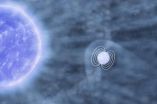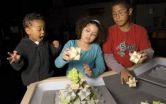(Press-News.org) Children and adolescents who eat candy tend to weigh less than their non-consuming counterparts, according to a new study published in Food & Nutrition Research, a peer-reviewed journal.
This is potentially important news given the current state of the childhood obesity epidemic. But lead researcher Carol O'Neil, PhD, MPH, LDN, RD, Louisiana State University Agricultural Center, wants to ensure the study is put into perspective.
"The study illustrates that children and adolescents who consume candy are less likely to be overweight or obese," O'Neil said. "However, the results of this study should not be construed as a hall-pass to overindulge. Candy should not replace nutrient-dense foods in the diet; it is a special treat and should be enjoyed in moderation."
Similar to a sister study that focused on adults (published earlier this year in Nutrition Research), this study examined the association of candy consumption on intakes of total energy, fat, and added sugars; diet quality; weight/adiposity parameters; and risk factors for cardiovascular disease in 11,182 U.S. children 2-13 years of age and adolescents 14-18 years of age participating in the 1999-2004 National Health and Nutrition Examination Survey (NHANES).
Striking a Balance: Candy and Health
While children and adolescent candy consumers in the study did have slightly higher intakes of total energy and added sugars, they were 22 percent and 26 percent, respectively, less likely to be overweight or obese than non-candy consumers—suggesting their ability to successfully navigate the "calories in, calories out," balance over time.
Specific findings include:
Cardiovascular Risk Factors: It was a positive finding that C-reactive protein (CRP), a non-specific marker of inflammation and one way to assess risk for cardiovascular and other chronic diseases, was actually lower in sugar candy consumers. There were no other associations between candy consumption and cardiovascular risk factors, including no difference in blood pressure or blood lipid levels (a cholesterol indicator).
Diet Quality: Diet quality was measured by the Healthy Eating Index 2005, a standard created by the U.S. Department of Agriculture to assess conformance to federal dietary guidance. The study found overall, there was no difference in diet quality in candy consumers compared with non-consumers. It is worth noting however, that overall diet quality was very poor in all groups, regardless of whether candy was consumed.
Weight, Body Mass Index (BMI) and Waist Circumference: These key measures for overweight and obesity were lower for candy consumers as compared to non-consumers.
"Candy is a fun part of children's lives – as a treat, in celebrations and for holidays," said Alison Bodor, senior vice president of public policy and advocacy, National Confectioners Association. "It's not intended to replace nutrient-dense foods in the diet, but it certainly can provide moments of happiness within the context of a healthy lifestyle."
INFORMATION:
The article abstract can be accessed here: http://www.foodandnutritionresearch.net/index.php/fnr/article/view/5794
FUNDING DISCLOSURE: The study is a publication of the United States Department of Agriculture (USDA/ARS) Children's Nutrition Research Center, Department of Pediatrics, Baylor College of Medicine, Houston, Texas. The contents of this publication do not necessarily reflect the views or policies of the USDA, nor does mention of trade names, commercial products, or organizations imply endorsement from the U.S. government.
This research project was supported by the USDA Agricultural Research Service through specific cooperative agreement 58-6250-6-003. Partial support was received from the USDA Hatch Project LAB 93951. Partial support was also received from the National Confectioners Association.
END
ESA's XMM-Newton space observatory has watched a faint star flare up at X-ray wavelengths to almost 10 000 times its normal brightness. Astronomers believe the outburst was caused by the star trying to eat a giant clump of matter.
The flare took place on a neutron star, the collapsed heart of a once much larger star. Now about 10 km in diameter, the neutron star is so dense that it generates a strong gravitational field.
The clump of matter was much larger than the neutron star and came from its enormous blue supergiant companion star.
"This was a huge bullet of gas ...
The Hampton Inn & Suites Atlanta Airport Hotel (North, I-85) offers convenient lodging to attendees of the National Black Arts Festival, a celebration of the art, music, and culture of people of African descent. The summer festival takes place July 7-17, with a few visual arts exhibitions running longer. The main weekend of the festival is July 15-17, with events taking place at Centennial Olympic Park in downtown Atlanta. There are scheduled musical and dance performances as well as an International Marketplace and children's activities. Exhibitions of visual arts, ...
British researchers have identified specific resistance mutations for two classes of p7 inhibitor, which may explain their lack of effectiveness in clinical trials combined with current standard of care. Study results support the role of p7 inhibitor combinations as potential components of future HCV-specific therapies and are available in the July issue of Hepatology, a journal published by Wiley-Blackwell on behalf of the American Association for the Study of Liver Diseases.
More than 3% of the world population is infected with HCV, which causes severe liver disease. ...
This release is available in French.
Montreal, June 28, 2011 —Canadians aren't the only people concerned with weather, eh? A new study from McGill and Concordia universities observed pedestrians in nine cities around the world and found people are less likely to walk when temperatures dip below zero, when there's too much rain or too much snow. Published in the journal Environment and Behavior, the study was conducted over 170 days from late fall to early summer.
"A 5 degree Celsius increase in temperature was associated with a 14 per cent increase in pedestrians," ...
The Eatery on Beach Street has a new look on the inside and new menu items like Burger Diane and weekly specials like Friday's steak gone wild. The restaurant even has a new logo featuring a wine glass and new tagline.
The new logo and the new look are part of the restaurant's effort to attract a clientele that likes made-from-scratch American food with fresh ingredients and a creative twist.
"Chef Don likes to surprise patrons with a dish that mixes unexpected flavors or recreates a favorite recipe in a new form," said co-owner Cindy Gifford. She mentioned ...
New research confirms that a variant on the patatin-like phospholipase-3 (PNPLA3) gene increases risk of steatosis and fibrosis progression in patients with chronic hepatitis C virus (HCV). The PNPLA3 single nucleotide polymorphism (SNP) rs 738409 may represent an important genetic predictor and potential therapeutic target in chronic HCV liver damage. Study details are published in the July issue of Hepatology, a peer-reviewed journal of the American Association for the Study of Liver Diseases.
According to a report by the World Health Organization (WHO) roughly 170,000 ...
Bird species in rainforest fragments in Brazil that were isolated by deforestation disappeared then reappeared over a quarter-century, according to research results published today in the journal PLoS ONE.
Scientists thought many of the birds had gone extinct.
The research was funded by the National Science Foundation (NSF), and conducted in cooperation with Projeto Dinâmica Biológica de Fragmentos Florestais, Instituto Nacional de Pesquisas da Amazônia and the Smithsonian Tropical Research Institute in Manaus, Brazil.
Lead author Philip Stouffer, an ornithologist ...
From educators to leaders in industry, there is broad agreement that U.S. schools have a crucial challenge in improving teaching and learning in science, technology, engineering and math (STEM) among students from kindergarten through high school. A background in STEM is not only essential to many current and future careers; it is also a means for citizens to understand and participate in an increasingly complex world--from understanding the challenges of environmental sustainability to addressing the need for alternative sources of energy.
The NRC report, "Successful ...
New research by the University of Warwick and Humboldt university shows that the frequency of wars between states increased steadily from 1870 to 2001 by 2% a year on average. The research argues that conflict is being fed by economic growth and the proliferation of new borders.
We may think the world enjoyed periods of relative freedom from war between the Cold War and 9/1 but the new research by Professor Mark Harrison from at the University of Warwick's the Centre for Competitive Advantage in the Global Economy, and Professor Nikolaus Wolf from Humboldt University, ...
When Oxygen4Energy Athlete Kellie Wells got to Eugene, Oregon this past week, she had only one thing on her mind... winning a national championship. She knew that all of the nation's top competitors would also be there gunning for the title, but she was definitely up for the challenge.
So far this year, Kellie has been the most dominant figure in women's hurdles by tying an American Record (55m Hurdles), winning the Indoor National Title, running multiple World Lead times, winning the first Diamond League event, and never finishing worse than 2nd place in any race she ...



